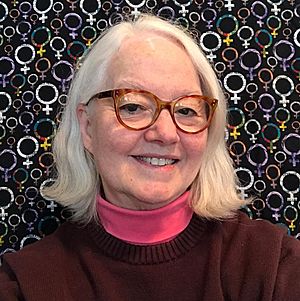Sandra Sider facts for kids
Quick facts for kids
Sandra Sider
|
|
|---|---|
 |
|
| Nationality | American |
| Education | New York University Institute of Fine Arts, University of North Carolina, Chapel Hill, Columbia University |
| Movement | Quilt art |
Sandra Sider, born in Alabama in 1949, is an American artist. She is known for her amazing quilt art, her writing, and for being a curator. A curator is someone who manages and organizes collections, often in a museum.
Sandra studied a lot! She earned a PhD in comparative literature from the University of North Carolina, Chapel Hill. This means she studied how different types of writing from various cultures are connected. She also has a master's degree in art history from the New York University Institute of Fine Arts.
She worked as a curator for the Texas Quilt Museum from 2012 until 2021. She was also the main editor for Art Quilt Quarterly magazine from 2017 until 2023.
Sandra has taught art history at several universities. These include the Cooper Union for the Advancement of Science and Art and the Fashion Institute of Technology in New York City. She also taught at Adelphi University and the University of Colorado online. From 2019 to 2022, she taught about the history of textiles at Parsons School of Design.
She has written many books and articles. Her writings cover topics like Renaissance history, visual culture, and modern quilt art. Some of her books include Maps, Charts, Globes: Five Centuries of Exploration. She wrote this when she was a curator at The Hispanic Society of America. Another book is Handbook to Life in Renaissance Europe. She also wrote Pioneering Quilt Artists, 1960–1980: A New Direction in American Art. Her most recent book is Quarantine Quilts: Creativity in the Midst of Chaos, published in 2021.
Contents
What Are Art Quilts?
Since the mid-1990s, Sandra Sider has created many quilts using a special method. She prints photographs onto fabric. These quilts are made from fabric squares. Each square has a part of a photo printed on it using a process called cyanotype.
How Cyanotype Works
Cyanotype is a way to put an image onto fabric using a special iron stain. It's a bit like making blueprints. The cloth needs to be treated so it reacts to light. When the image develops, the parts that would normally be dark appear light. This makes the images seem to glow, which can create a cool and surprising effect.
Sandra's Unique Style
Sandra's quilts use traditional quilting ideas, like block shapes and repeating patterns. But she also adds modern art ideas. Her work often uses techniques found in postmodern art.
Each fabric square in her quilts has only a part of an image. Sometimes these parts are different sizes. This creates a fragmented look that makes your eyes move around the quilt to see all the details. Sandra mixes old quilting styles with new design ideas. She has been inspired by famous 20th-century artists like Robert Rauschenberg and Andy Warhol.
In 2023, Sandra had a special art show. It was at the Artifact Gallery in New York City. This show featured only her cyanotype quilt art.
Helping Art Quilts Get Noticed
Sandra Sider has worked hard to help museums collect more art quilts. She believes that if museums see how exciting art quilts are, they will want to add them to their collections.
Quilts in Museums
Sandra did a survey of 140 museums in the United States. She found that these museums have over 1,800 art quilts in their collections. Some of these museums are very famous. They include the American Folk Art Museum, the Baltimore Museum of Art, and the Solomon R. Guggenheim Museum. The Renwick Gallery at the Smithsonian American Art Museum also has art quilts.
Why Museums Should Collect Quilts
Sandra believes it's important for museum curators to have good information about art quilts. When a museum committee decides to buy or accept a quilt, they ask questions. They want to know how the quilt fits into their collection or if it can be part of an exhibit. Curators need to show solid information about other art quilts to help the committee decide.
Sandra has noticed that museums are collecting more art quilts now. Her survey looked at quilts made after the year 2000. She found that almost 25 percent of all the art quilts in her survey were made after 2000. This shows that many museums are interested in collecting modern quilt art.

